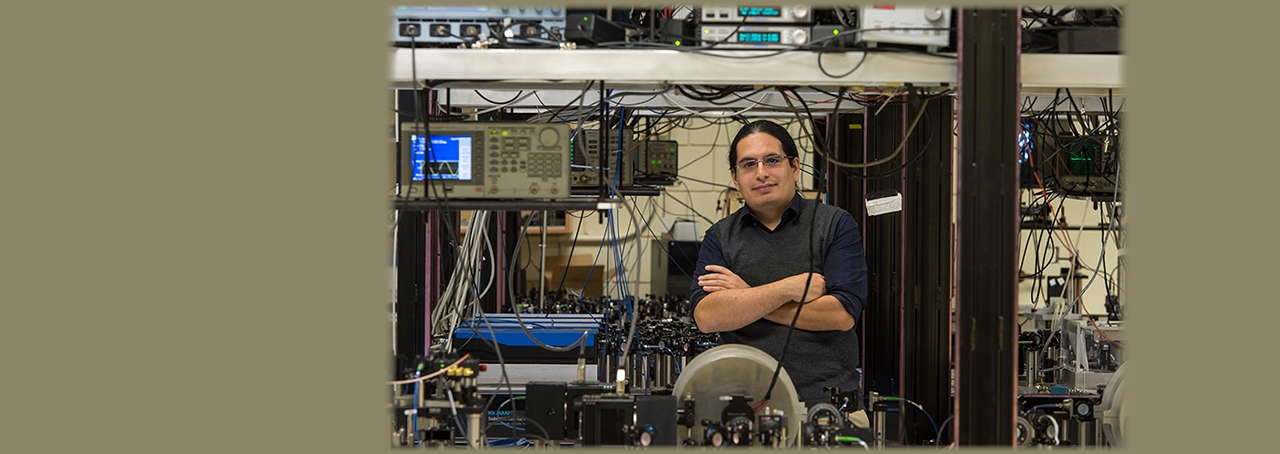Statewide Coalition Plans the Future of Quantum Communications
“2020 was a big year for quantum communications,” said Eden Figueroa, an associate professor of physics at Stony Brook University (SBU) with a joint researcher appointment at Brookhaven National Laboratory (BNL), noting that the U.S. Department of Energy unveiled its Blueprint for a Quantum Internet on July 23 – the same day he oversaw the longest successful quantum communication link demonstration in the United States.
So, what would a quantum internet do, you ask? It would harness the behavior of matter and light at the atomic and subatomic level – photons, electrons, and other particles – to create an unhackable network that can store and send enormous amounts of data over vast distances!
As part of a federally funded quantum network development program, the research team demonstrated a three-node quantum network prototype that achieved transmission of single-photon level polarization quantum bits (“qubits”) in a configuration covering approximately 140 km (roughly 87 miles), using commercially available telecommunications fiber connecting the SBU and BNL campuses. An important aspect of the experiment, according to Figueroa, is that the qubits used were fully quantum memory compatible, which is critical for future commercial adoption.
In the meantime, Figueroa and the Quantum Information Sciences & Technology groups at SBU and BNL continue to develop novel quantum memories and processors that will enable future quantum information networks and computing. In a recent paper from this past January, the researchers propose solutions to two critical barriers – 1. reliance on cryogenics/vacuum equipment and 2. the lack of quantum repeaters – that hinder the real-world deployment and market adoption of a quantum internet.
In this new experiment the team has now deployed quantum memory buffers, atom-filled glass cells that store quantum information and are manipulated using lasers to control their atomic states, to produce fiber compatible telecom photons. Using quantum interference of the telecom photons at BNL, two quantum memories located at SBU are now connected over a fiber network of approximately 168 km (roughly 104 miles).
Developing a quantum repeater network
Upgrading the current traditional fiber-based communication technologies into secure entanglement-based quantum communication networks requires a new generation of devices serving as the foundation of a new quantum internet. A suite of these devices is under development at SBU spinout Qunnect The company, which was founded in 2017 to commercialize the technologies coming out of SBU’s Quantum Information Technology Lab, is commercializing tools that enable a hybrid quantum internet – long-distance, quantum-secure communication on existing telecommunications infrastructure.
Expanding the current SBU-BNL testbed to form a full-fledged entanglement distribution quantum repeater network, using Qunnect’s devices, is cited as one of 10 Exciting Engineering Milestones to look for in 2021 by IEEE, the world's largest technical professional organization dedicated to advancing technology for the benefit of humanity.
New York quantum coalition: towards a New York state quantum internet
A statewide coalition envisions turning this first-of-its-kind quantum network prototype into a large-scale memory-assisted entanglement distribution quantum network that stretches from Long Island to Buffalo. That effort was boosted in September 2020 with the launch of the Innovare Advancement Center in Rome, NY.
Created in partnership by the Air Force Research Laboratory Information Directorate, Griffiss Institute, Oneida County, and The State University of New York, Innovare enables a robust high-tech entrepreneurial, R&D, and educational ecosystem for the region and the nation by driving advancements in key strategic areas, including quantum. Innovare is a significant step forward in implementing the National Quantum Initiative Act, which aims to foster the development of a quantum technology ecosystem among government, industry, and academia.
In addition, research teams at SBU and the University at Buffalo demonstrated the power of collaboration when they leveraged two conceptualization grants from the National Science Foundation Quantum Leap Challenge Institutes program to develop and collaborate on a combined New York proposal for an initial award of up to $25M in federal funding.
The envisioned New York Center for a Scalable Hybrid Quantum Internet involves 11 universities and national laboratories, 17 industry partners, and five government agencies across New York, comprising multidisciplinary groups of scientists and engineers with expertise in quantum communication, quantum materials, and engineering. Large-scale strategic partners and early-stage investors will actively support the proposed Center, which will establish industry-led research translation and commercialization pathways to help accelerate the transition of technology from the lab to market. This effort also aims to facilitate the development of training and education programs focusing on developing a new quantum-smart workforce.
comments powered by Disqus


